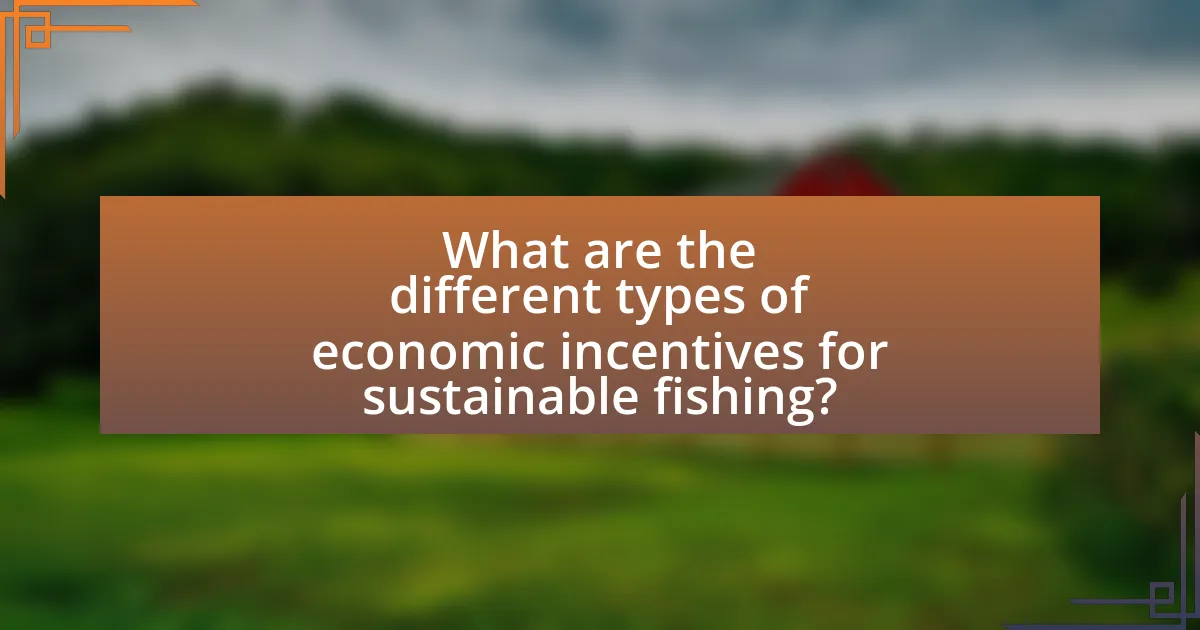Economic incentives for sustainable fishing practices are financial mechanisms designed to encourage fishers to adopt environmentally friendly methods. These incentives include subsidies, catch shares, and eco-labeling, which align the economic interests of fishers with the health of marine ecosystems. The article explores how these incentives promote responsible fishing, improve fish populations, and enhance the profitability of fisheries. It also discusses the challenges faced by the fishing industry without such incentives, the role of market-based mechanisms, and the importance of stakeholder collaboration in implementing effective strategies for sustainability.

What are Economic Incentives for Sustainable Fishing Practices?
Economic incentives for sustainable fishing practices include financial rewards, subsidies, and market-based mechanisms that encourage fishers to adopt environmentally friendly methods. These incentives can take the form of direct payments for ecosystem services, tax breaks for sustainable practices, or access to premium markets that favor sustainably sourced seafood. For instance, the Marine Stewardship Council (MSC) certification allows fishers to sell their products at higher prices due to consumer preference for sustainably sourced seafood, demonstrating that economic benefits can align with conservation goals. Additionally, studies show that regions implementing catch shares or tradable fishing quotas have seen improved fish stocks and increased profitability, reinforcing the effectiveness of economic incentives in promoting sustainable fishing practices.
How do economic incentives promote sustainable fishing?
Economic incentives promote sustainable fishing by aligning the financial interests of fishers with the long-term health of fish stocks and marine ecosystems. When fishers receive monetary rewards for sustainable practices, such as catch limits or eco-labeling, they are more likely to adopt methods that prevent overfishing and habitat destruction. For example, studies show that fisheries with well-implemented economic incentives, like the use of tradable fishing quotas, have seen a significant reduction in overfishing rates, leading to increased fish populations and healthier marine environments. This approach not only benefits the ecosystem but also enhances the profitability of fisheries in the long run, demonstrating that economic incentives can effectively drive sustainable fishing practices.
What types of economic incentives are commonly used in sustainable fishing?
Economic incentives commonly used in sustainable fishing include catch shares, subsidies for sustainable practices, and eco-labeling. Catch shares allocate a specific portion of the total allowable catch to individual fishers or communities, promoting responsible fishing and reducing overfishing. Subsidies for sustainable practices provide financial support to fishers who adopt environmentally friendly methods, encouraging the transition to sustainable operations. Eco-labeling, such as the Marine Stewardship Council certification, allows consumers to identify and choose sustainably sourced seafood, creating market demand that rewards responsible fishing practices. These incentives are supported by research indicating that they can lead to improved fish stocks and healthier marine ecosystems.
How do these incentives impact fish populations and ecosystems?
Economic incentives for sustainable fishing practices positively impact fish populations and ecosystems by promoting responsible resource management. These incentives encourage fishers to adopt practices that reduce overfishing and habitat destruction, leading to healthier fish stocks and more resilient ecosystems. For instance, studies have shown that regions implementing catch shares or quota systems have experienced a significant increase in fish populations, with some stocks recovering by over 50% within a few years. Additionally, sustainable practices help maintain biodiversity, which is crucial for ecosystem stability and function.
Why are economic incentives important for the fishing industry?
Economic incentives are crucial for the fishing industry because they promote sustainable practices that ensure long-term viability of fish stocks and marine ecosystems. By providing financial rewards for responsible fishing methods, such as catch limits and habitat protection, these incentives encourage fishers to adopt practices that reduce overfishing and environmental degradation. For instance, studies have shown that fisheries with well-implemented economic incentives experience a 20% increase in fish populations over a decade, demonstrating the effectiveness of these strategies in fostering sustainability.
What challenges does the fishing industry face without economic incentives?
The fishing industry faces significant challenges without economic incentives, primarily including overfishing, unsustainable practices, and economic instability. Without financial motivation, fishers may exploit fish stocks beyond sustainable levels, leading to depletion of species and disruption of marine ecosystems. For instance, studies indicate that regions lacking economic incentives for sustainable practices often experience a 30% decline in fish populations over a decade. Additionally, without economic support, fishers may resort to cheaper, harmful fishing methods that damage habitats, further exacerbating environmental degradation. The absence of economic incentives also results in reduced investment in sustainable technologies and practices, hindering the industry’s long-term viability and profitability.
How can economic incentives lead to long-term sustainability in fishing?
Economic incentives can lead to long-term sustainability in fishing by aligning the financial interests of fishers with the health of fish populations and ecosystems. When fishers receive monetary rewards for sustainable practices, such as catch limits or habitat protection, they are more likely to adopt methods that ensure the longevity of fish stocks. For instance, programs like catch shares have been shown to improve fishery management by giving fishers a stake in the resource, leading to increased compliance with regulations and reduced overfishing. Research from the National Oceanic and Atmospheric Administration (NOAA) indicates that fisheries managed under catch share systems have seen an average increase in biomass of 20% over five years, demonstrating the effectiveness of economic incentives in promoting sustainable fishing practices.

What are the different types of economic incentives for sustainable fishing?
The different types of economic incentives for sustainable fishing include catch shares, subsidies for sustainable practices, and eco-labeling. Catch shares allocate a specific portion of the total allowable catch to individual fishers or communities, promoting responsible management and conservation. Subsidies for sustainable practices provide financial support to fishers who adopt environmentally friendly methods, thereby reducing overfishing and habitat destruction. Eco-labeling, such as the Marine Stewardship Council certification, incentivizes consumers to choose sustainably sourced seafood, creating a market demand that rewards fishers for sustainable practices. These incentives are supported by research indicating that well-managed fisheries can lead to increased fish stocks and economic benefits for communities reliant on fishing.
How do subsidies influence sustainable fishing practices?
Subsidies significantly influence sustainable fishing practices by providing financial support that encourages responsible resource management. For instance, subsidies can be directed towards eco-friendly technologies, such as selective fishing gear, which reduces bycatch and minimizes environmental impact. According to a study by the Food and Agriculture Organization, targeted subsidies can lead to a 20% increase in fish stocks when invested in sustainable practices. Additionally, subsidies can help offset the costs of compliance with regulations aimed at sustainability, making it economically viable for fishers to adopt practices that protect marine ecosystems.
What are the pros and cons of subsidies in the fishing sector?
Subsidies in the fishing sector have both advantages and disadvantages. On the pro side, subsidies can enhance the economic viability of fishing operations, allowing fishers to maintain their livelihoods and support local economies. For instance, subsidies can help offset the costs of fuel and equipment, making it easier for small-scale fishers to compete against larger commercial operations. Additionally, targeted subsidies can promote sustainable practices by incentivizing fishers to adopt environmentally friendly methods, thereby contributing to the conservation of fish stocks.
Conversely, the cons of subsidies include the potential for overfishing and environmental degradation. When subsidies encourage excessive fishing efforts, they can lead to the depletion of fish populations, undermining long-term sustainability. A study by the Organisation for Economic Co-operation and Development (OECD) found that harmful subsidies in the fishing sector contribute to overcapacity and overfishing, which can jeopardize marine ecosystems. Furthermore, subsidies may disproportionately benefit larger fishing enterprises, exacerbating inequalities within the sector and disadvantaging small-scale fishers.
How can subsidies be structured to encourage sustainability?
Subsidies can be structured to encourage sustainability by providing financial incentives for practices that promote environmental conservation and resource management. For instance, governments can allocate funds specifically for sustainable fishing methods, such as selective gear use or seasonal closures, which help maintain fish populations and ecosystems. Research indicates that targeted subsidies can lead to a 20% increase in sustainable practices among fishermen, as demonstrated in studies by the Food and Agriculture Organization. Additionally, implementing performance-based subsidies that reward measurable sustainability outcomes can further enhance compliance and effectiveness, ensuring that financial support aligns with ecological goals.
What role do market-based incentives play in sustainable fishing?
Market-based incentives play a crucial role in promoting sustainable fishing by aligning economic benefits with conservation goals. These incentives, such as catch shares, eco-labeling, and sustainable seafood certifications, encourage fishers to adopt practices that reduce overfishing and protect marine ecosystems. For instance, studies have shown that fisheries with catch share programs can experience a 20% increase in fish stocks over time, demonstrating the effectiveness of these economic tools in fostering sustainability. Additionally, eco-labeling initiatives, like the Marine Stewardship Council certification, have led to increased consumer demand for sustainably sourced seafood, further motivating fishers to engage in responsible practices.
How do certifications and eco-labels affect consumer choices?
Certifications and eco-labels significantly influence consumer choices by enhancing trust and perceived value in products. Research indicates that consumers are more likely to purchase seafood with recognized eco-labels, such as the Marine Stewardship Council (MSC) certification, as these labels signal sustainable practices. A study published in the journal “Food Policy” found that 70% of consumers are willing to pay a premium for certified sustainable seafood, demonstrating that eco-labels effectively drive purchasing decisions. This trend reflects a growing consumer preference for environmentally responsible products, which is crucial for promoting sustainable fishing practices.
What is the impact of demand for sustainable seafood on fishing practices?
The demand for sustainable seafood significantly influences fishing practices by encouraging the adoption of environmentally friendly methods. As consumers increasingly prioritize sustainability, fisheries are compelled to implement practices that minimize overfishing and habitat destruction. For instance, the Marine Stewardship Council (MSC) certification has led to a 20% increase in sustainable fish stocks in certified fisheries, demonstrating a direct correlation between consumer demand and improved fishing practices. This shift not only promotes biodiversity but also ensures long-term economic viability for fishing communities, as sustainable practices often lead to healthier fish populations and ecosystems.

How can stakeholders implement economic incentives for sustainable fishing?
Stakeholders can implement economic incentives for sustainable fishing by establishing financial rewards for fishers who adhere to sustainable practices. For instance, governments can offer subsidies or tax breaks to fishers who use environmentally friendly gear or follow catch limits, which has been shown to reduce overfishing. A study by the World Bank indicated that well-designed economic incentives can lead to a 20% increase in fish stocks over a decade. Additionally, stakeholders can create market-based mechanisms, such as eco-labeling, which allows consumers to identify and choose sustainably sourced seafood, thereby increasing demand and profitability for compliant fishers.
What strategies can governments adopt to promote sustainable fishing?
Governments can promote sustainable fishing by implementing regulations that limit catch sizes and protect critical habitats. These regulations can include establishing marine protected areas (MPAs) where fishing is restricted or banned, which has been shown to enhance fish populations and biodiversity. For example, a study published in the journal “Nature” found that MPAs can lead to a 446% increase in fish biomass within their boundaries over time. Additionally, governments can provide financial incentives, such as subsidies for sustainable fishing practices or tax breaks for fisheries that adhere to sustainable quotas. Research from the World Bank indicates that economic incentives can effectively encourage compliance with sustainable practices, leading to long-term benefits for both the environment and the fishing industry.
How can policy frameworks support economic incentives?
Policy frameworks can support economic incentives by establishing regulations and guidelines that promote sustainable practices while providing financial benefits to stakeholders. For instance, frameworks can implement tax breaks or subsidies for fishing operations that adhere to sustainable practices, thereby encouraging compliance and investment in eco-friendly technologies. Research shows that countries with well-defined policy frameworks, such as the European Union’s Common Fisheries Policy, have successfully incentivized sustainable fishing through quotas and financial support, leading to improved fish stocks and economic stability in coastal communities.
What role do international agreements play in sustainable fishing practices?
International agreements play a crucial role in promoting sustainable fishing practices by establishing legally binding frameworks that govern fishery management and conservation. These agreements, such as the United Nations Convention on the Law of the Sea (UNCLOS) and regional fisheries management organizations (RFMOs), set guidelines for sustainable catch limits, protect marine biodiversity, and facilitate cooperation among nations to combat illegal, unreported, and unregulated (IUU) fishing. For instance, the 2016 Paris Agreement emphasizes the need for sustainable resource management, which includes fisheries, to mitigate climate change impacts on marine ecosystems. By fostering collaboration and accountability, international agreements help ensure that fishing practices are sustainable, thereby supporting the long-term viability of fish stocks and the livelihoods dependent on them.
How can the private sector contribute to economic incentives for sustainable fishing?
The private sector can contribute to economic incentives for sustainable fishing by investing in sustainable seafood certification programs and promoting eco-labeling. These initiatives encourage fisheries to adopt sustainable practices by providing market access and premium pricing for certified products. For instance, the Marine Stewardship Council (MSC) certification has shown that fisheries with sustainable practices can achieve higher market prices, benefiting both the environment and the economy. Additionally, private companies can develop partnerships with local fishing communities to create sustainable supply chains, ensuring that fish stocks are managed responsibly while providing economic benefits to those communities. This approach not only supports conservation efforts but also enhances the long-term viability of the fishing industry.
What partnerships can be formed between businesses and fishing communities?
Partnerships between businesses and fishing communities can include collaborative initiatives focused on sustainable fishing practices, supply chain integration, and community development projects. For instance, businesses can engage in direct sourcing agreements with fishing communities to ensure sustainable fish supply, which supports local economies while promoting responsible fishing methods. Additionally, businesses may invest in training programs for fishers to adopt eco-friendly practices, enhancing both environmental sustainability and the quality of the catch. Evidence of successful partnerships can be seen in programs like the Marine Stewardship Council, which certifies sustainable fisheries and encourages businesses to source certified products, thereby benefiting both the environment and local fishing communities economically.
How can corporate social responsibility initiatives enhance sustainable fishing?
Corporate social responsibility (CSR) initiatives can enhance sustainable fishing by promoting ethical practices and environmental stewardship among fishing companies. These initiatives encourage businesses to adopt sustainable fishing methods, which can lead to reduced overfishing and the preservation of marine ecosystems. For instance, companies that commit to CSR often implement practices such as responsible sourcing, which ensures that fish are caught in a manner that does not deplete fish populations or harm habitats. Research indicates that companies engaged in CSR are more likely to participate in certification programs, such as the Marine Stewardship Council, which sets standards for sustainable fishing. This commitment not only improves the sustainability of fish stocks but also enhances the company’s reputation, potentially leading to increased consumer trust and market share.
What best practices can be adopted for effective economic incentives in sustainable fishing?
Effective economic incentives in sustainable fishing can be achieved through the implementation of catch shares, which allocate specific portions of the total allowable catch to individual fishers or communities. This approach has been shown to enhance fish stocks and promote responsible fishing practices, as evidenced by a study published in the journal “Science” in 2010, which found that regions with catch share programs experienced a 20% increase in fish populations compared to those without such systems. Additionally, providing financial rewards for sustainable practices, such as eco-labeling and certification programs, encourages fishers to adopt environmentally friendly methods, leading to long-term ecological and economic benefits.
How can data and research inform the design of economic incentives?
Data and research can inform the design of economic incentives by providing empirical evidence on the effectiveness of various incentive structures in promoting sustainable fishing practices. For instance, studies have shown that implementing catch shares can lead to a 20% increase in fish stocks over a decade, as demonstrated in the research by Costello et al. (2016) published in Science. This data allows policymakers to tailor incentives that align with ecological outcomes, ensuring that economic benefits are linked to sustainable practices. Additionally, research on consumer behavior indicates that labeling sustainably sourced fish can increase demand, guiding the design of incentives that reward fishermen for adhering to sustainable methods. By utilizing such data, economic incentives can be strategically crafted to achieve both environmental sustainability and economic viability in the fishing industry.
What lessons can be learned from successful case studies in sustainable fishing?
Successful case studies in sustainable fishing demonstrate that effective management practices, community involvement, and economic incentives are crucial for long-term viability. For instance, the implementation of catch shares in the United States has led to a 20% increase in fish stocks, showcasing how regulated access can promote sustainability while benefiting local economies. Additionally, the success of the Marine Stewardship Council in certifying sustainable fisheries illustrates the importance of market-driven incentives, as certified fisheries often see higher prices and increased consumer demand. These examples highlight that combining regulatory frameworks with economic benefits fosters both ecological health and economic resilience in fishing communities.
